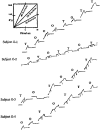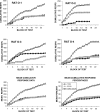Stimulus control and compounding with ambient odor as a discriminative stimulus on a free-operant baseline
- PMID: 17465315
- PMCID: PMC1832170
- DOI: 10.1901/jeab.2007.35-06
Stimulus control and compounding with ambient odor as a discriminative stimulus on a free-operant baseline
Abstract
Previous experiments have demonstrated that the simultaneous presentation of independently established discriminative stimuli can control rates of operant responding substantially higher than the rates occasioned by the individual stimuli. This "additive summation" phenomenon has been shown with a variety of different reinforcers (e.g., food, water, shock avoidance, cocaine, and heroin). Discriminative stimuli previously used in such studies have been limited to the visual and auditory sensory modalities. The present experiment sought to (1) establish stimulus control on a free-operant baseline with an ambient olfactory discriminative stimulus, (2) compare olfactory control to that produced with an auditory discriminative stimulus, and (3) determine whether compounding independently established olfactory and auditory discriminative stimuli produces additive summation. Rats lever pressed for food on a variable-interval schedule in the presence of either a tone or an odor, with comparable control developed to each stimulus. In the absence of these stimuli responding was not reinforced. During stimulus compounding tests, the tone-plus-odor compound occasioned more than double the responses occasioned by either the tone or odor presented individually. Thus, the current study (1) established stimulus control with an ambient olfactory discriminative stimulus in a traditional free-operant setting and (2) extended the generality of stimulus-compounding effects by demonstrating additive summation when olfactory and auditory discriminative stimuli were presented simultaneously.
Figures




Similar articles
-
Reinstatement of a food-maintained operant produced by compounding discriminative stimuli.Behav Processes. 2005 Sep 30;70(2):194-202. doi: 10.1016/j.beproc.2005.04.007. Behav Processes. 2005. PMID: 15939551
-
Compounding discriminative stimuli controlling free-operant avoidance.J Exp Anal Behav. 1972 Mar;17(2):249-56. doi: 10.1901/jeab.1972.17-249. J Exp Anal Behav. 1972. PMID: 16811586 Free PMC article.
-
A comparison of the effects of discriminative and Pavlovian inhibitors and excitors on instrumental responding.Behav Processes. 2008 May;78(1):53-63. doi: 10.1016/j.beproc.2008.01.003. Epub 2008 Jan 12. Behav Processes. 2008. PMID: 18304758
-
Drug Discrimination: Historical Origins, Important Concepts, and Principles.Curr Top Behav Neurosci. 2018;39:3-26. doi: 10.1007/7854_2018_40. Curr Top Behav Neurosci. 2018. PMID: 29637526 Review.
-
Operant conditioning in motor and neural integration.Neurosci Biobehav Rev. 1986 Winter;10(4):387-429. doi: 10.1016/0149-7634(86)90004-7. Neurosci Biobehav Rev. 1986. PMID: 3543755 Review.
Cited by
-
An analysis of verbal stimulus control in intraverbal behavior: implications for practice and applied research.Anal Verbal Behav. 2013;29(1):125-35. doi: 10.1007/BF03393130. Anal Verbal Behav. 2013. PMID: 23814373 Free PMC article.
-
The Journal of the Experimental Analysis of Behavior at zero, fifty, and one hundred.J Exp Anal Behav. 2008 Jan;89(1):111-8. doi: 10.1901/jeab.2008.89-111. J Exp Anal Behav. 2008. PMID: 18338678 Free PMC article.
-
An inexpensive and automated method for presenting olfactory or tactile stimuli to rats in a two-choice discrimination task.J Exp Anal Behav. 2008 Jul;90(1):113-24. doi: 10.1901/jeab.2008.90-113. J Exp Anal Behav. 2008. PMID: 18683616 Free PMC article.
References
-
- Barr G.A, Rossi G. Conditioned place preference from ventral tegmental injection of morphine in neonatal rats. Developmental Brain Research. 1992;66:133–136. - PubMed
-
- Braun J.J, Marcus J. Stimulus generalization among odorants by rats. Physiology & Behavior. 1969;4:245–248.
-
- Darling F.M.C, Slotnick B.M. Odor-cued taste avoidance: A simple and efficient method for assessing olfactory detection, discrimination and memory in the rat. Physiology & Behavior. 1994;55:817–822. - PubMed
-
- Durlach P.J, Rescorla R.A. Potentiation rather than overshadowing in flavor-aversion learning: An analysis of within-compound associations. Journal of Experimental Psychology: Animal Behavior Processes. 1980;6:175–187. - PubMed
Publication types
MeSH terms
Grants and funding
LinkOut - more resources
Full Text Sources

